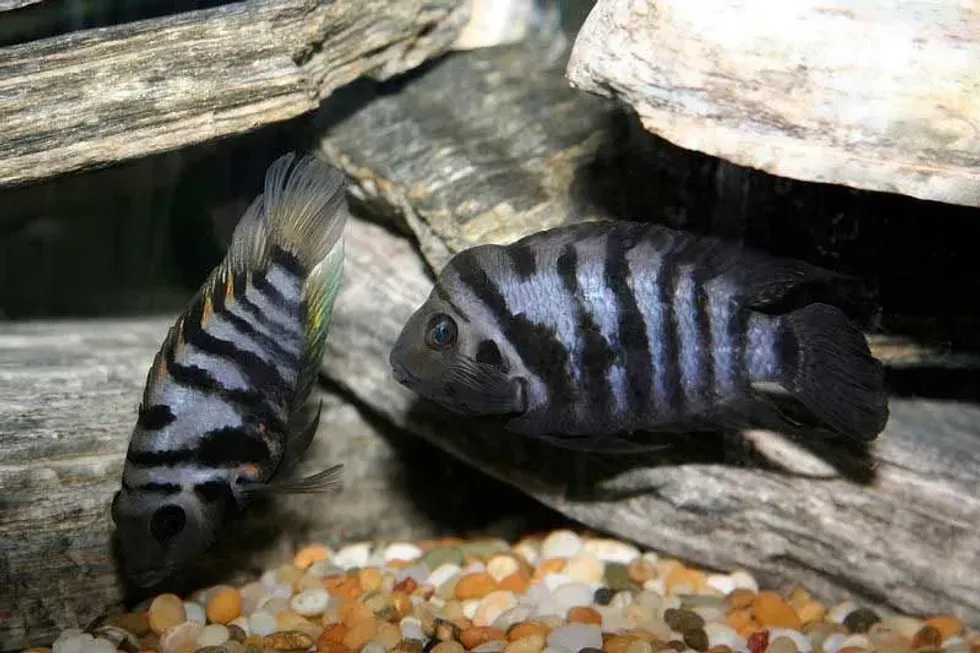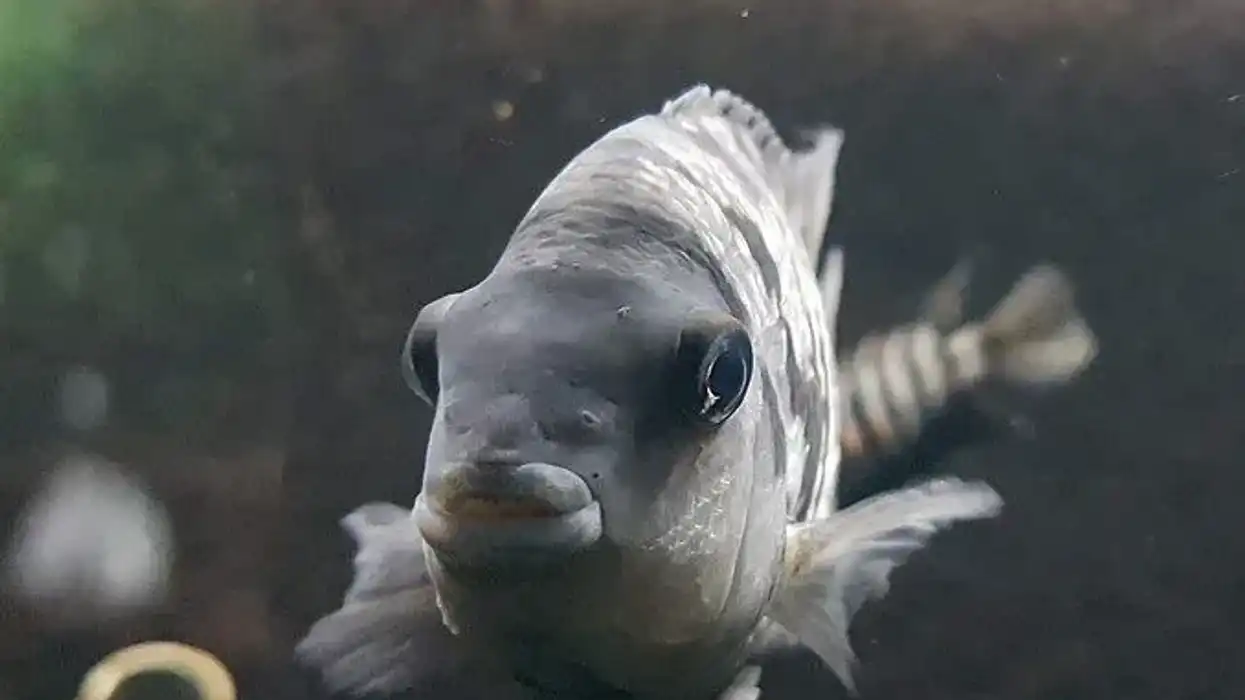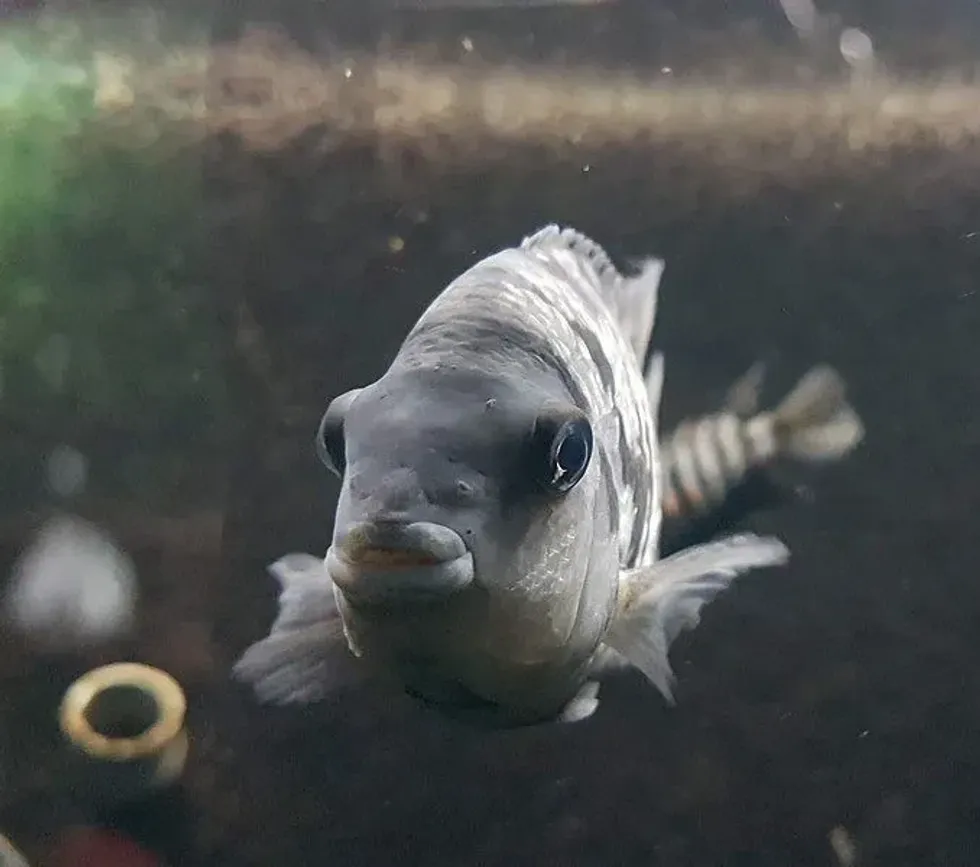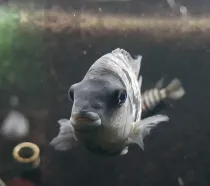Fun Convict Cichlid Facts For Kids

Content
- What type of animal is a Convict Cichlid?
- What class of animal does a Convict Cichlid belong to?
- How many Convict Cichlids are there in the world?
- Where does a Convict Cichlid live?
- What is a Convict Cichlid's habitat?
- Who do Convict Cichlids live with?
- How long does a Convict Cichlid live?
- How do they reproduce?
- What is their conservation status?
- What do Convict Cichlids look like?
- How cute are they?
- How do they communicate?
- How big is a Convict Cichlid?
- How fast can a Convict Cichlid swim?
- How much does a Convict Cichlid weigh?
- What are their male and female names of the species?
- What would you call a baby Convict Cichlid?
- What do they eat?
- Are they dangerous?
- Would they make a good pet?
- Did you know...
- Can Convict Cichlids live with other fish?
- Different types of Convict Cichlid
If you are looking to get into taking care of a fish, then get home some Convict Cichlids! These fish are resilient enough to survive a volcano's cooling pools and will definitely thrive in your community tank (provided there are no tank mates).
This freshwater fish is native to Central America and is also called the Zebra Cichlid.
In addition to being found in your tank, Cichlids are also found in various other locations in the world (where they do not really belong). These places include locations as far as Japan, Mexico, Australia, the USA, Columbia, and Taiwan.
Talk about a global fish! However, just because they are smaller in size and look very adorable, do not be fooled.
They are very aggressive fish and will not hesitate to defend their territory, whether in a community tank or the ocean. These fish will bite, nip, circle, and do everything in their power to push away any fish that does not belong in their territory.
The males are larger than females, and the larger the male, the more his chances of having a monogamous partner who can lay eggs and help him defend their territory.
Curious to know more? Then read on ahead, and check out other fish like the piranha fish and scorpionfish once you're done.
Convict Cichlid Interesting Facts
What type of animal is a Convict Cichlid?
The Convict Cichlid (Amatitlania nigrofasciata) is a type of fish.
What class of animal does a Convict Cichlid belong to?
The Convict Cichlid (Amatitlania nigrofasciata) belongs to the fish class.
How many Convict Cichlids are there in the world?
Due to the constant discovery of new species and scientific breakthroughs, the Amatitlania nigrofasciata is undetermined. In addition to this, their prolific breeding skills also keep bolstering their population so that keeping track of their numbers is near impossible. Even if you keep them in a tank, they can manifold their numbers in less than a year.
Where does a Convict Cichlid live?
You can find a Convict Cichlid living in an ocean. They are very durable fish and can undergo extreme water temperature changes and current flows too.
This is why they are some of the only fish who can safely live under and around volcanoes. They have been discovered living in the cooling ponds of several natural, active volcanoes. However, when not chilling with their friends under a volcano, these species are found in fast-moving waters with shallow bedrock and isolation.
What is a Convict Cichlid's habitat?
The Convict Cichlid prefers swimming in flowing waters, and as such is frequently found in lakes, rivers, and streams. They hide in large rocks and crevices on the ocean floor.
You can see them in Central America, from Panama, Honduras to Guatemala and Costa Rica. However, they (particularly the black Convict Cichlid) have managed to migrate to several other unlikely locations, too, such as Japan, Australia, Mexico, and more.
This is a testament to their durability, and their ability t0 live in unlikely conditions. In fact, they were once discovered living under an active volcano!
Who do Convict Cichlids live with?
The Convict Cichlid lives alone for the most part. They only step out of their habitat to mate and lay eggs and are intensely territorial and aggressive.
Though they are not big enough to eat many other fish, they will definitely attack and harass the other fish until they leave the tank.
Since they can't leave the tank on their own, things may become complicated. This is why it is recommended that they not share their tanks with any other fish (even if it is of the same species) and be kept only one in a tank.
How long does a Convict Cichlid live?
The Convict Cichlid lives for approximately 8-10 years, though if treated well in captivity, it is not uncommon for them to age up to 12 years old. Unlike many other fish, they thrive in captivity and are the perfect fish to initiate you into being an aquarium owner.
However, while they may be very hardy fish, it is important to keep note of their lifestyle, as changing their environment too fast, or too frequently, will result in them dying early, or developing diseases.
How do they reproduce?
The Convict Cichlids are notorious for reproducing multiple times a year. The male Convict will create a cave-like opening for the female Convict to lay eggs in. The male will then fertilize those eggs.
They will both protect the Convict Cichlid eggs for 72 hours, after which the fish absorb their yolk and are free-swimming. Overall, this entire process takes 10 days to take place. If they are kept in a tank, you can speed this process by feeding them more often, changing tank water, and keeping it clean.
What is their conservation status?
The IUNC Red List marks this species of fish as Least Concern. The Convict Cichlids breed very often, even if they are tank mates or in a community tank, and as a result, keep their population levels high.
Convict Cichlid Fun Facts
What do Convict Cichlids look like?
The Convict Cichlids are small fish of between four to six inches, with eight to nine black stripes running down their bodies.
Also called the Zebra Cichlid for the same reason, the Cichlid fish will reach sexual maturity at just seven months old. Males are larger than females, and it will be impossible to tell the male and female apart until the Cichlids reach sexual maturity.
Once they reach sexual maturity, the stripes become more apparent on the females and there will be some bright coloration on their belly too.

How cute are they?
The Convict Cichlid is an adorable species of fish and a perfect addition to your tank. They are hardy fish who look adorable and have scales that will shimmer in the sun.
Also, they change color! A dominant male in the tank will have a darker shade of color than others in the tank or aquarium. If they are aggressive, about to attack, or in a foul mood, you may see their pigmentation darken then.
How do they communicate?
The Convict Cichlid is a very aggressive, hardy fish and communicates this. They are very territorial and will bite, push, attack or move their fins around other fish.
They will also blow bubbles and circle around those they see as a threat. They do not have vocal cords and so communicate with their bodies.
They will also spin around, shake their dorsal fin, and make their color differences more distinct to give the illusion of having a bigger body. They also have teeth which they may use to bite those they see as a threat.
How big is a Convict Cichlid?
The Convict Cichlids are between four to six inches tall. That is almost as tall as a small-scale ruler.
The female is always a bit smaller than the male, though she is always more brightly colored. Her black stripes are most distinct, in a more vibrant hue, and in general, better than those of the male. This is one of the biggest ways to differentiate between them.
While they are young, unfortunately, there is almost no way of telling these creatures apart, unless we check their sex organs. Your local pet dealer may know, so do not hesitate in asking.
How fast can a Convict Cichlid swim?
There is no researched speed at which the Convict Cichlid can swim. However, they can be fast swimmers and are often seen swimming against the current.
They also prefer moving waters instead of still waters (unlike many other fish), which means they are definitely good and fast swimmers. This moving water allows them to escape predators, chase prey, and move quickly enough to hide if needed.
How much does a Convict Cichlid weigh?
The Convict Cichlids weigh between 1.2-1.3 oz. This makes them one of the lightest species of their family, with several other heavy-weight cousins in colder waters.
What are their male and female names of the species?
There is no particular name for the male Convict Cichlid fish and the female Convict Cichlid fish. There is also very little way to tell them apart until they grow into adults. Then their markings and size change, though these differences are only marginal.
What would you call a baby Convict Cichlid?
There is no particular name for the baby Convict Cichlids. The small Cichlids group is occasionally called small Fry, but this is a trend observed for all fish, not just the Cichlids. They are very common animals when looking for pets, though, and you can adopt one for yourself, and give it a unique name!
What do they eat?
In the wild, they can eat almost anything they can take in their mouths: small crustaceans, smaller fish, phytoplankton, insects, grain, and more.
However, if this fish species is in a tank, it is good to feed them high-quality fish food such as brine shrimp. Brine Shrimp not only ensures they get all the nutrients they need but is also a quick option to feed them when you do not have proper fish food on hand.
It is recommended that you space out their portions across a day to prevent weight-related issues.
Are they dangerous?
Not at all. The Convict Cichlids are an aggressive species, especially in small tank sizes, but they are no danger to humans.
Though they have teeth, even if the Cichlids bite humans, it will not be a problem at all. Their teeth are too small to do any noticeable damage. However, if you make them share tanks with other species, they may end up hurt from their attacks.
Would they make a good pet?
Absolutely! They are the perfect pet for beginners, intermediate and expert fish caretakers. Even though they can survive in some very extreme water conditions, if you recreate their natural habitat as well as possible, then you will see your freshwater fish thriving in your tank. They grow relatively fast and achieve sexual maturity in about seven to eight months.
The first step is setting up a good aquarium. Since they are consistent diggers, it would be a good idea to set up lots of rocks, caves, and nooks, and crevices for your aquarium fish to hide in.
You can use sand, driftwood, and plants strongly anchored to the floor because these small fish enjoy re-arranging the items in their natural habitat.
They love eating brine shrimp, and though the bare minimum in terms of tank size is 30 gallons, it is recommended you upgrade the tank size to at least 50 gallons. It is advised that you feed them thrice in a single day, in smaller portions, so the tank does not get polluted.
You should also regularly clean and change the tank water to ensure that they have enough oxygen, nutrients, and other things; the Cichlids need to survive and lay eggs and breed in general.
Any filtration system should be external instead of undergravel because they tend to dig a lot. They also like to eat aquatic plants on occasion, so if you choose to put any plastic plants in their tank, make sure it can withstand the bites, or your fishes may end up eating plastic and damaging their bodies.
Did you know...
It is straightforward to breed a pair of convicts. The Convict Cichlids are known for their notorious ability to breed multiple times in a single year, and all you have to do is to set the mood for them!
The first thing you need is a 50-gallon tank, at the very least. The next step is setting up the floor with rocks, pebbles, and a 'cave' for them to lay eggs in.
Even a flower pot, a deep bowl, or a dark-colored glass would do; the breeding pair of Convicts will not be very picky about it. The final thing you must keep in mind when breeding Convict Cichlids is the water temperature between 79-84°F.
And that is all! Now all you need to do is put a male and a female Convict Cichlids in the 50-gallon tank, and voilà, you can look forward to seeing some smaller aquarium fish in no time at all.
At one given breeding season, you can expect them to around 30 small fry in a tank. However, even though the Convict Cichlids are biparental creatures (which means that both Cichlid fish look after the baby Cichlids together), it is usually a good idea to shift the male to another tank as soon as the fry are born.
This is because the male Cichlid (Convict) may become aggressive towards them too.
Will they eat their young? Well, it is not completely unheard of.
There have been cases recorded where this species eats their own young. However, since they play an active role in caretaking, such incidents are the exception, not the rule.
Can Convict Cichlids live with other fish?
No, they can not. The Convict Cichlids are relatively aggressive, which means they do not do well with tank mates.
Even if these tank mates belong to their own species, they will be seen attacking, pushing, and generally bullying them, especially if they are smaller or less aggressive fish. Even though the minimum tank you should have is 50 gallons, consider having a bigger one if you plan on keeping Cichlids you hope to see breeding.
Overall, it is best to leave these fish on their own and not attempt to put other fish in with them unless you are an expert fish caretaker, in which case consider putting in fish larger than them in the community tank or just as aggressive, if not more.
It will help them stand their ground when the Cichlids come bullying them.
Some possible examples are the Pictus Catfish, the Giant Danio, and the Green Terror. However, even though there are some fishes they can live with, it is highly recommended that they be kept separately.
If they are to be kept with other fish, then you should keep them in a tank where each fish can have around 50 gallons worth of space.
Different types of Convict Cichlid
One of the major differences between the various species of Convict Cichlids is the color. They had started as the black Convict Cichlid but are now found in variations.
You can now bring home a blue Convict Cichlid, pink Convict Cichlid, gold Convict Cichlids, and more due to selective breeding. This is why if you plan on having them breed, do make sure you do not breed the black Convict with any other color.
Since the multiple shades are recessive traits and not the dominant ones, any fry born out of black and colored breeding will be black. The multiple hues and colors are a result of a recessive color trait in the breed, and as such, are in danger of being overtaken by more dominant color traits.
Here at Kidadl, we have carefully created lots of interesting family-friendly animal facts for everyone to discover! Learn more about some other fish, including green sunfish, or wels catfish.
You can even occupy yourself at home by drawing one on our Convict cichlid coloring pages.
We Want Your Photos!
More for You
Sources
https://www.fishkeepingworld.com/convict-cichlid/
https://en.wikipedia.org/wiki/Convict_cichlid
https://www.aquariumsource.com/convict-cichlid/
See All
Bachelor of Arts specializing in English Language, Master of Philosophy

Devangana RathoreBachelor of Arts specializing in English Language, Master of Philosophy
Devangana is a highly accomplished content writer and a deep thinker with a Master's degree in Philosophy from Trinity College, Dublin. With a wealth of experience in copywriting, she has worked with The Career Coach in Dublin and is constantly looking to enhance her skills through online courses from some of the world's leading universities. Devangana has a strong background in computer science and is also an accomplished editor and social media manager. Her leadership skills were honed during her time as the literacy society president and student president at the University of Delhi.
Bachelor of Technology specializing in Information Technology

Smriti ChaudharyBachelor of Technology specializing in Information Technology
Smriti, a student data scientist, and coder, is pursuing her Bachelor of Technology at K.J. Somaiya College of Engineering. She has achieved top rankings in the International English Olympiad, National Spelling Bee, and PSAT/SAT English Section. She is experienced in content creation and editing for various academic institutions.
Disclaimer
1) Kidadl is independent and to make our service free to you the reader we are supported by advertising. We hope you love our recommendations for products and services! What we suggest is selected independently by the Kidadl team. If you purchase using the Buy Now button we may earn a small commission. This does not influence our choices. Prices are correct and items are available at the time the article was published but we cannot guarantee that on the time of reading. Please note that Kidadl is a participant in the Amazon Services LLC Associates Program, an affiliate advertising program designed to provide a means for sites to earn advertising fees by advertising and linking to Amazon. We also link to other websites, but are not responsible for their content.
2) At Kidadl, we strive to recommend the very best activities and events. We will always aim to give you accurate information at the date of publication - however, information does change, so it’s important you do your own research, double-check and make the decision that is right for your family. We recognise that not all activities and ideas are appropriate for all children and families or in all circumstances. Our recommended activities are based on age but these are a guide. We recommend that these ideas are used as inspiration, that ideas are undertaken with appropriate adult supervision, and that each adult uses their own discretion and knowledge of their children to consider the safety and suitability. Kidadl cannot accept liability for the execution of these ideas, and parental supervision is advised at all times, as safety is paramount. Anyone using the information provided by Kidadl does so at their own risk and we can not accept liability if things go wrong.
3) Because we are an educational resource, we have quotes and facts about a range of historical and modern figures. We do not endorse the actions of or rhetoric of all the people included in these collections, but we think they are important for growing minds to learn about under the guidance of parents or guardians.







